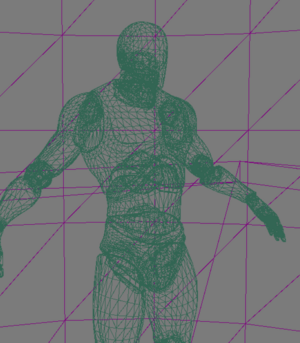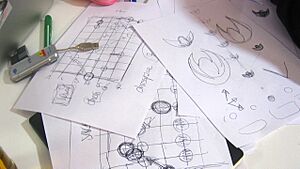Video game design facts for kids
Video game design is all about creating the fun and exciting worlds of video games! It's the process of planning the rules, stories, characters, and environments that make a game come alive. Think of it as building a whole new world for players to explore.
A video game designer is like the director of a movie. They have a big vision for the game and guide the team to make it happen. For really big games, like online role-playing games (called MMORPGs) or huge action games, there can be many designers working together. Usually, there's a main designer, and then other designers focus on different parts of the game.
In the past, the people who programmed games often designed them too. Famous designers like Sid Meier and Will Wright started this way. But as games became more complex and computers got more powerful, game design became its own special job. Now, teams have dedicated designers who focus only on making the game fun and engaging.
Contents
What is Video Game Design?
Video game design starts with an idea. This idea might be something new, or it might build on an existing game concept. Designers often try mixing different game types to create something unique.
First, a game designer usually writes a plan. This plan describes the game's idea, how it will be played, what features it will have, its setting and story, and who it's for. It also estimates how much time and money will be needed.
Many choices are made while a game is being developed. The designer decides which parts of the game will be included. They have to think about if the idea fits the game's overall vision, the budget, and what the game system can handle. Changes in design can greatly affect how many resources are needed.
Designers sometimes use special computer languages to try out their ideas without changing the main game code. They also play many other video games to see what's new and popular in the market.
It's important to remember that many people work together to make a game. While a designer's name might become well-known, the whole team helps create the final product.
Games are often made to be sold and make money. This means that publishers (the companies that fund games) often have ideas about what the game should be like. However, some games are made because of a designer's unique vision, especially by indie game developers who might get funding from crowdfunding. Other games are made to show off new technology, like Quake, or to highlight amazing art, like Myst and Journey.
Who is a Game Designer?
A game designer is a person who creates the gameplay. They think up and design the rules and structure of a game. Many designers start their careers by testing games or in other roles, learning from what works and what doesn't.
- Lead designer: This person guides the other designers and is the main visionary for the game. They make sure the team communicates well, make big design choices, and present the game's vision to others. They often understand both the technical and artistic sides of game making.
- Game mechanics designer: This designer creates and balances the game's rules. They make sure the game is fair and fun to play.
- Level designer: This role has become very important recently. A level designer creates the game's environments, levels, and missions.
- Planner: This is what game designers are often called in the Japanese video game industry.
How Much Do Game Designers Earn?
Salaries for game designers can vary based on experience and location. In 2013, a game designer with less than three years of experience earned about $55,000 per year. Those with more than six years of experience made around $105,000 per year. By 2020, the average yearly pay for a game designer in the United States was about $130,000.
Different Design Jobs
World Design
World design is about creating the background story, setting, and overall theme for the game. This is often done by the lead designer. It can involve creating an entire universe or a detailed map, and thinking about the areas players will explore. World design helps shape the direction the game takes.
System Design
System design is about creating the game's rules and the math behind them. It's how the game reacts to the player's actions. The "experience" a player has comes from how the game's system is designed. A complex system can lead to many different and exciting events, making the player feel more involved in the game.
Content Design
Content design involves creating characters, items, puzzles, missions, or anything that adds extra fun and value to the game. These are the things that make a game rich and interesting, beyond just its basic functions.
Game Writing
Game writing means writing the dialogue, text, and story for the game. This is one of the first steps in making a video game. It includes how the story is told, whether through voice acting, on-screen text, pictures, or music.
Level Design
Level design is the process of building the game's levels and their features. Level designers use many different skills to create a game world. They use lighting, space, and color to guide the player's attention. A designer can use these elements to direct players through the game world or even to trick them!
User Interface Design
User interface (UI) design focuses on how players interact with the game and how the game gives them information. This includes things like menus and heads-up displays (the information you see on screen while playing, like your health bar).
UI design also connects with game mechanics. Designers decide how much information to give the player and how to show it. This can inform players about the world or keep them guessing. They also decide how players will control the game. These choices greatly affect the game's mood and how players feel while playing.
Audio Design
Audio design is about creating or adding all the sounds in the game. This includes music, sound effects, and voice acting. It covers everything from the main theme song to the little jingles you hear in menus.
User Experience Design
All the design jobs mentioned above work together to create the overall "feel" of the game. User experience design makes sure that the game flows smoothly and that players interact well with all its parts.
Game Elements
Narrative (Story)
Many games have a story or narrative. This story gives meaning to what happens in the game, making it more entertaining. Even if a game doesn't have a clear story, some experts believe all games have a narrative element. For example, the original Tetris doesn't have a story, but some people still see a kind of narrative in it. A story can be the starting point for a game, or it can be added later to a game that began with just its rules.
Gameplay
Gameplay is the interactive part of video game design. It's how players interact with the game, usually to have fun, learn something, or practice skills.
The Design Process
Coming Up with Ideas
The way designers work can be different for each person and company. A common way to start is with a new idea or by building on an existing game. From there, designers create a game design document. This document is like a detailed blueprint for the entire game. It helps the whole development team understand the vision and is updated as the game is made.
Different Roles for Designers
Designers often need to do many different things. For example, they might use existing game engines like Unity or Godot to quickly test out new ideas. Level designs might first be drawn on paper, then built using 3D modeling tools. Designers also use special scripting languages to control things like artificial intelligence (AI), cutscenes (short movie-like scenes), and how the environment behaves. They also research and write about the game's setting, story, and characters. Designers might even oversee testing with players and create lists of art and sound needed for the game. Besides these skills, designers need to be good at communicating clearly and paying attention to details.
Getting Design Approval
In the world of commercial games, getting design approval is an ongoing process from the very beginning until the game is finished. When a new project is discussed, the designer might write a short summary of the game's concept. Then, they might create a one or two-page pitch describing specific features, the target audience, and other details. Designers first meet with leaders from other departments to make sure the game can actually be made within the available time and budget. If the idea is approved, the next step is to create a detailed design document. Some developers like to build a quick test version (a prototype) before writing the full document, just to try out new ideas.
Making Decisions During Production
As the game is being made, designers often have to make quick decisions about parts that weren't fully planned. It's hard to know the full impact of these decisions until they are actually built into the game. The faster these "unknowns" are discovered, the less risk the team faces later on. Sometimes, things like budget cuts or changes in deadlines can force parts of the design to be removed. While big cuts can hurt a project, sometimes they can also make the game simpler and more focused, with only the best features polished well.
Finishing Up and Quality Check
Towards the end of making a game, designers are responsible for making sure the gameplay is consistently good throughout the entire game, even if it's a very long one. This can be tough, especially during "crunch" time, when the team is working very hard to finish the game and fix all the bugs.
Game Design Tools
In the past, game designers used simple tools like word processors, spreadsheets, or even just pen and paper. As game design has grown, and things like player choice and different languages became more important, there was a need for special tools for this field.
For writing stories and dialogue, software like articy:draft 3 and Twine are used. These tools help in the early stages of design, before the visual art and programming begin.
There are also many free 3D design software programs available. Some, like Blender, focus mainly on graphics. Others, like Unreal Engine and Unity, are full game engines that have communities where people learn from each other and share 3D models and tutorials.
See Also
 In Spanish: Diseño de juegos para niños
In Spanish: Diseño de juegos para niños
- Game art design
- List of video game designers
- List of video gaming topics
- Designing educational games
- Narrative Designer




